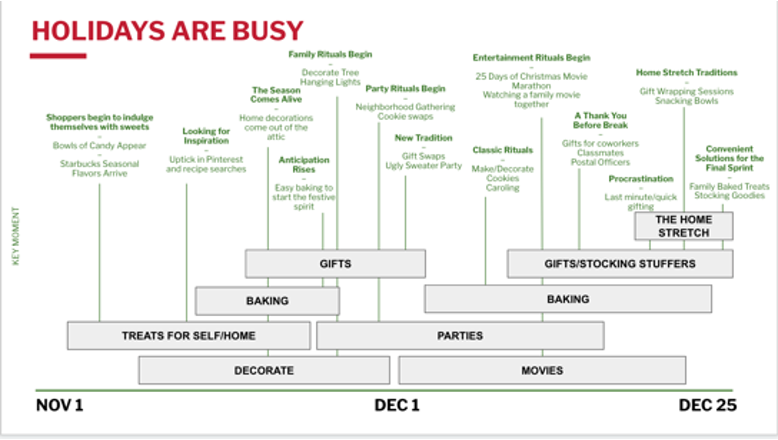By Melissa Wightman, The Mars Agency
The following is the final article in a three-part series examining “Game-Changing Ecommerce Partnerships.” The first article examined “The Ecommerce Partnership Advantage,” while the second looked at “Picking the Ideal Marketing Partner.”

With both your strategy and marketing partner in place, the last critical step is to develop an activation plan that will optimize the program by maximizing the experience for your target shoppers.
As we’ve stressed throughout this discussion, the plan needs to be guided by your goals and objectives. If you’re promoting a new use for your product or a new solution for shoppers, you might want to leverage tools like Pinterest Trends to understand potential interest. You’ll also want to consider timing: Does the program have an evergreen window, or will it be tied to a specific time frame? Can you use it to jumpstart a key season?
Getting the Timing Right
Try to avoid highly competitive windows. As one obvious example, in the graphic below, look at all of the activities (from a marketer’s perspective) that a shopper might experience within the two key holiday season months. With all these things swirling in their heads, shoppers might not have the extra headspace to engage with your message, which could get lost in all the competitive clutter.

What’s more, it can be more costly to run your program during a peak season, which would hurt your performance by reducing the ROI even if you do sell a lot of products. Therefore, we’d suggest staying away from the Q4 time period, given the potential costs and the additional competition for shopper time and attention.
And for programs on Amazon, we’d also suggest avoiding Prime Day, which seems attractive on paper due to the sheer number of eyeballs that you might reach. But Prime Day is such a competitive event that it will be much harder to be discoverable, so it’s probably not the best time to launch a partnership program.
Instead, evaluate the calendar to see if there is white space on the calendar you can take advantage to introduce the program to shoppers. Leveraging your partnership with Amazon Advertising to evaluate the spending habits of your competitors might help find an ideal window.
Getting the Bundle Right
How do you plan to sell the partnering products to shoppers? You basically have three general options:
1. You can sell the products as an actual physical package. This, of course, will require a longer lead time than other options and can be more challenging given all the supply chain, logistics and order fulfillment issues you’ll need to manage. But if you need a physical package to achieve your goal, just understand that you’ll need to start planning a lot earlier.
2. Virtual bundles are a great alternative for achieving the look of a physical experience by simply pulling together the items and creating a custom ASIN (Amazon Standard Identification Number). It will appear as if they products are combined, and they will be shipped together to the shopper.
3. In the simplest option, you can just creatively merchandise the items together by developing a landing page experience that lets shoppers buy everything together from a single destination. This option can be activated in a matter of weeks.

Getting the Discovery Right
Next, how will you get shoppers to discover the program? Here are a few methods to consider..
SEO: If you are using a new product ASIN or a virtual bundle ASIN, make sure that your title is keyword-optimized and you’re bidding on the relevant keywords. Remember that it takes a little while to fuel the algorithm and start getting discovered.
Targeted Media: If you go this route, make sure that both partners are running the same media and driving shoppers to a single destination for the program.
Shared Merchandising: If your program is running on Amazon Fresh, take advantage of any JBP placements you might have; maybe you use your paid Amazon Shoveler placement for a couple of weeks, and then get your partner to use their placement. That will double your awareness, double your audience, and extend your reach.
Deals: Make sure your deal is discoverable not just on your Brand Store or PDP, but also on the general deal tabs on Amazon and/or Amazon Fresh.
Owned Channels: And then leverage the heck out of your own channels — social, newsletters, email, CRM tools — to drive shoppers to the Brand Store or PDP.
Getting the Audience Right
What audience segments will be best for this partnership?
Is there Contextual Relevance that might be important to consider? If your solution will be best experienced through an air fryer, for instance, owners of that appliance might be a relevant target.
Retargeting visitors to the partners’ Brand Stores partner — as well as those of your competitors — could attract relevant shoppers.
Amazon and Amazon Fresh: We’ve had success with partnership programs that run on one platform or the other. But you’ll gain much better exposure by taking advantage of the strong insights and audience segments you get using both platforms.
Amazon Properties: Amazon isn’t just a retailer, it’s media property and a platform — and that can be hugely beneficial. In the past, we’ve leveraged the audience on Twitch, and now Amazon Prime has a Thursday Night Football streaming audience (as one example) that might be relevant.
Custom Audiences: Reach out to your Amazon Advertising team to determine where you can pull in custom audiences like Prime Student or Spanish-language speakers.
And, of course, don’t forget about your brand buyers and category browsers. You might even evaluate your Brand or Category Development Index (BDI or CDI) to see where you should do some geo-targeting.
Getting Conversion Right
Whatever else you might be trying to do, you want to drive growth for your product by getting shoppers to convert. And you want to do that in the most efficient way possible. Here are some ways you can do that.
Through content. Once shoppers get to the promotional page, they need to understand the benefits of buying these items together. That requires custom content that clearly explains the reasons, the reward you’re offering or the solution you’re providing.
Through a promotion: You need to give shoppers a reason to take advantage of the partnership through a call to action that will make them want to buy both products. It might be a unique idea for using the two Items together, or it might be a more straightforward purchase incentive.
Through a discount: To get them over the hurdle of what might be trading up from their typical purchase or buying something completely new, you might need to sweeten the deal with a price discount. This will increase the program’s costs, of course, so it’s worth taking the time to determine if the bundled promotion or solution can stand on its own.
Through a new usage idea: The ideal partnership will inspire shoppers to think about using your product in a completely different way or for a different occasion that they hadn’t considered before (with no discount needed).
Key Watchouts
As with any kind of program activation, there are a few watchouts to remember:
Don’t bid on the same keywords. Make sure you and your partner stay in your own swim lanes, so to speak. You obviously don’t want to accidentally drive up the competitive pricing by bidding on the same keywords.
Don’t duplicate the audience. Similarly, leverage each other’s audience to broaden your reach while avoiding duplication. One of the greatest benefits of the partnership is the opportunity to get in front of a rich new audience with which your partner already has experience engaging.
Ensure content consistency. To make sure that your audience is getting a consistent, integrated experience, assign an owner to the task. It could be an agency partner, or someone on the internal creative team, or even a member of the Amazon Advertising team who is responsible for ensuring that you present a mirror image of the content across all PDPs, Brand Stores and campaign landing pages.
Keep track of inventory. Finally, take the time to ensure inventory availability and profitability. For some programs, we even have alternate creative featuring other items at the ready in case we run into issues and need to flip the switch quickly.
Key Takeaways
To provide a quick recap of everything we’ve discussed in this series, here the key takeaways for building a successful ecommerce partnership program on Amazon or anywhere else.
1. Define Your Goals. This is the most important step, to make sure you’re jumping into things with crystal clear expectations.
2. Do Your Research. Leverage all the great tools that we discussed earlier to identify the best partner.
3. Gain Alignment. Put together a solid partnership agreement that outlines how you’ll measure success. This will be the jumping-off point for optimizing all your activity.
I would caution here against using ROAS as your default performance metric. You really should go back to the partnership goals to determine what your metrics should be. No two partnership programs that I’ve ever developed have been exactly the same, and your metrics should reflect the unique objectives of each one.
4. Give Yourself Learning Room. Set a budget and an activation plan that provides enough resources and time to gain learnings by trying different merchandising placements, deals, discount ranges, ASINs, or just messages. This not only will help you improve results from the program, it will also give you the insights needed to build a stronger long-term strategy.
At a minimum, we recommend eight weeks to let you gather some of these learnings. But you might want to reserve a little additional budget so you can activate some of those initial learnings — maybe for another eight weeks.
Speaking of budget-setting, there are no general guidelines for how much you need to spend to execute an effective program. The Mars Agency has conducted successful programs that cost as little as $25,000 for each partner, which can buy you enough of a media campaign to gather some of those learnings.
And if you’re merely looking to prove a concept or maybe evaluate some potential partnerships, you could use your Brand Store and some other owned assets — PR, social, email, etc. — to drive a little engagement and test a program to see if it might be scalable.
As we’ve been saying all along, that’s just one of the many benefits of an ecommerce partnership program.

About the Author
Melissa Wightman is VP-Ecommerce at The Mars Agency. An industry veteran with over 25 years of shopper marketing experience, she has worked closely with multiple CPG clients in the food and healthcare industries. Over the last 9 years, Wightman has helped build the agency’s growing ecommerce practice, and now works with her team of content, creative and media experts to deliver innovative solutions that drive growth for clients. Reach her at [email protected].



